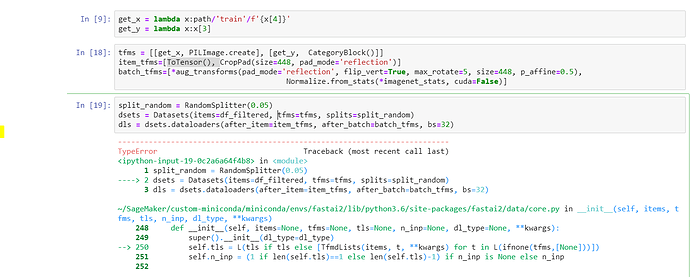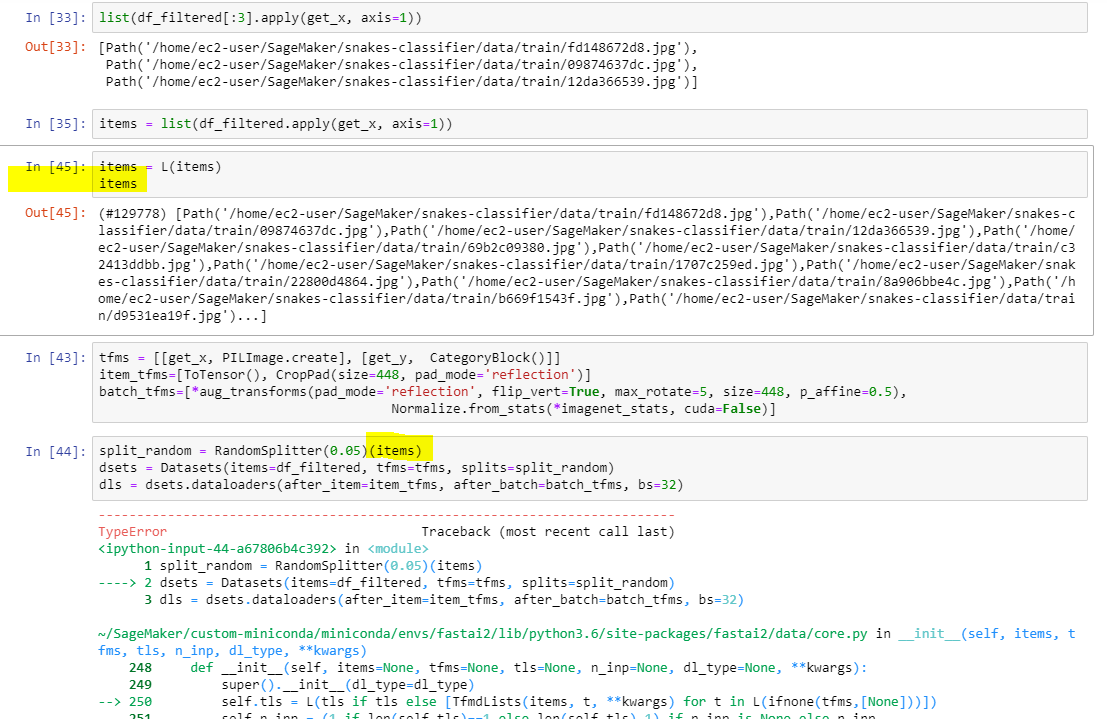I’d recommend the previous notebooks at the very least so you get used to the new API. Up to lesson 3 and you should be alright. But sprinkled in the lessons are techniques that can be applied for tabular and NLP too (like Cross Validation, etc) so to each their own. Weeks 5- end of vision not so much, as those are very vision specific.
I found using Ranger optimtizer and Mish activation function makes efficientnet training much easier! Heres my repo with fastaiv2 examples: https://github.com/morganmcg1/stanford-cars
I am trying to deploy a classifier based on fastai2 using these resources 02_Deployment.ipynb, teddy bear classifier.
The model works fine on colab and I have a fastai-v3 version running successfully,
however when running the fastai2 version of the code locally it is stuck in analyzing.
I receive the following error in the console (sorry about the length of the error but I wanted to give as much information as possible).
(venv) (base) Mrs-MacBook-Pro:fastai-v3-master fabulous$ python app/server.py serve
INFO: Started server process [97187]
INFO: Waiting for application startup.
INFO: Uvicorn running on http://0.0.0.0:5000 (Press CTRL+C to quit)
INFO: ('127.0.0.1', 57587) - "GET / HTTP/1.1" 200
INFO: ('127.0.0.1', 57587) - "GET /static/style.css HTTP/1.1" 200
INFO: ('127.0.0.1', 57588) - "GET /static/client.js HTTP/1.1" 200
INFO: ('127.0.0.1', 57589) - "GET /favicon.ico HTTP/1.1" 404
INFO: ('127.0.0.1', 57635) - "POST /analyze HTTP/1.1" 500
ERROR: Exception in ASGI application
Traceback (most recent call last):
File "/Users/fabulous/fastai2_20200114/artists_classifier/venv/lib/python3.7/site-packages/uvicorn/protocols/http/httptools_impl.py", line 368, in run_asgi
result = await app(self.scope, self.receive, self.send)
File "/Users/fabulous/fastai2_20200114/artists_classifier/venv/lib/python3.7/site-packages/starlette/applications.py", line 133, in __call__
await self.error_middleware(scope, receive, send)
File "/Users/fabulous/fastai2_20200114/artists_classifier/venv/lib/python3.7/site-packages/starlette/middleware/errors.py", line 122, in __call__
raise exc from None
File "/Users/fabulous/fastai2_20200114/artists_classifier/venv/lib/python3.7/site-packages/starlette/middleware/errors.py", line 100, in __call__
await self.app(scope, receive, _send)
File "/Users/fabulous/fastai2_20200114/artists_classifier/venv/lib/python3.7/site-packages/starlette/middleware/cors.py", line 84, in __call__
await self.simple_response(scope, receive, send, request_headers=headers)
File "/Users/fabulous/fastai2_20200114/artists_classifier/venv/lib/python3.7/site-packages/starlette/middleware/cors.py", line 140, in simple_response
await self.app(scope, receive, send)
File "/Users/fabulous/fastai2_20200114/artists_classifier/venv/lib/python3.7/site-packages/starlette/exceptions.py", line 73, in __call__
raise exc from None
File "/Users/fabulous/fastai2_20200114/artists_classifier/venv/lib/python3.7/site-packages/starlette/exceptions.py", line 62, in __call__
await self.app(scope, receive, sender)
File "/Users/fabulous/fastai2_20200114/artists_classifier/venv/lib/python3.7/site-packages/starlette/routing.py", line 585, in __call__
await route(scope, receive, send)
File "/Users/fabulous/fastai2_20200114/artists_classifier/venv/lib/python3.7/site-packages/starlette/routing.py", line 207, in __call__
await self.app(scope, receive, send)
File "/Users/fabulous/fastai2_20200114/artists_classifier/venv/lib/python3.7/site-packages/starlette/routing.py", line 40, in app
response = await func(request)
File "app/server.py", line 158, in analyze
pred = learn.predict(BytesIO(img_bytes))[0]
File "/Users/fabulous/fastai2_20200114/artists_classifier/venv/lib/python3.7/site-packages/fastai2/learner.py", line 325, in predict
dl = self.dls.test_dl([item], rm_type_tfms=rm_type_tfms)
File "/Users/fabulous/fastai2_20200114/artists_classifier/venv/lib/python3.7/site-packages/fastai2/data/core.py", line 315, in test_dl
test_ds = test_set(self.valid_ds, test_items, rm_tfms=rm_type_tfms) if isinstance(self.valid_ds, Datasets) else test_items
File "/Users/fabulous/fastai2_20200114/artists_classifier/venv/lib/python3.7/site-packages/fastai2/data/core.py", line 305, in test_set
if rm_tfms is None: rm_tfms = [tl.infer_idx(test_items[0]) for tl in test_tls]
File "/Users/fabulous/fastai2_20200114/artists_classifier/venv/lib/python3.7/site-packages/fastai2/data/core.py", line 305, in <listcomp>
if rm_tfms is None: rm_tfms = [tl.infer_idx(test_items[0]) for tl in test_tls]
File "/Users/fabulous/fastai2_20200114/artists_classifier/venv/lib/python3.7/site-packages/fastai2/data/core.py", line 222, in infer_idx
assert idx < len(self.types), f"Expected an input of type in \n{pretty_types}\n but got {type(x)}"
AssertionError: Expected an input of type in
- <class 'pathlib.PosixPath'>
- <class 'pathlib.Path'>
- <class 'str'>
- <class 'torch.Tensor'>
- <class 'numpy.ndarray'>
- <class 'bytes'>
- <class 'fastai2.vision.core.PILImage'>
but got <class '_io.BytesIO'>
The snippet of code I believe could be generating the error is located in the server.py file.
@app.route('/analyze', methods=['POST'])
async def analyze(request):
img_data = await request.form()
img_bytes = await (img_data['file'].read())
pred = learn.predict(BytesIO(img_bytes))[0]
return JSONResponse({
'results': str(pred)
Question?
Has anyone got any suggestions how I might fault find the cause of this error?
I have had a look here in fastai2.vision.core but not sure if this is a cause or symptom.
Cheers mrfabulous1 

@mrfabulous1 predict should be able to use BytesIO okay… (the lesson 2 from the course even shows it). @sgugger is the deployment example wrong and we need to convert BytesIO into something else?
It all depends if you can feed that to PILImage.create successfully or not. If you can, then that type needs to be added in the type annotation. It’s possible it works, it’s just predict has a defensive mechanism to make sure it gets data of the right type, and if it hasn’t seen that type at training (here it has seen Paths, not io objects) then it relies on the type annotation of the transforms to know it’s a safe type to get.
I’ll take a look today and put in a PR if it does
How do you get the image path from this dbunch? I can easily get the category but the x returns me the image… I just cannot figure it out 
Once the dbunch has been created…
@mgloria I may be a moment as I won’t get to look at things until tonight. Can you do a .path on it? (Curious) or .name? You can see the attributes by doing dir() on a variable
Sure! No dbunch.name, dbunch.path returns Path(’.’) and available methods as follow:
['__class__',
'__delattr__',
'__dict__',
'__dir__',
'__doc__',
'__eq__',
'__format__',
'__ge__',
'__getattr__',
'__getattribute__',
'__getitem__',
'__gt__',
'__hash__',
'__init__',
'__init_subclass__',
'__le__',
'__lt__',
'__module__',
'__ne__',
'__new__',
'__reduce__',
'__reduce_ex__',
'__repr__',
'__setattr__',
'__setstate__',
'__sizeof__',
'__str__',
'__subclasshook__',
'__weakref__',
'_default',
'_device',
'_dir',
'_docs',
'_xtra',
'add',
'add_na',
'after_batch',
'after_batch',
'after_item',
'after_item',
'after_iter',
'append',
'argwhere',
'as_item',
'as_item_force',
'attrgot',
'before_batch',
'before_batch',
'before_iter',
'bs',
'c',
'cat',
'categorize',
'chunkify',
'clear',
'concat',
'copy',
'count',
'cpu',
'create_batch',
'create_batches',
'create_item',
'cuda',
'cycle',
'dataloaders',
'dataloaders',
'dataset',
'decode',
'decode',
'decode',
'decode_batch',
'decodes',
'default',
'device',
'device',
'do_batch',
'do_item',
'drop_last',
'encodes',
'enumerate',
'fake_l',
'filter',
'from_dblock',
'fs',
'get_idxs',
'index',
'indexed',
'infer',
'infer_idx',
'init_enc',
'input_types',
'itemgot',
'items',
'items',
'loaders',
'loss_func',
'map',
'map_dict',
'map_zip',
'map_zipwith',
'n',
'n_inp',
'n_inp',
'n_subsets',
'n_subsets',
'new',
'new_empty',
'new_empty',
'nw',
'o',
'offs',
'one_batch',
'order',
'overlapping_splits',
'overlapping_splits',
'path',
'pin_memory',
'pop',
'prebatched',
'product',
'randomize',
'range',
'reduce',
'remove',
'retain',
'reverse',
'rng',
'sample',
'set_as_item',
'set_split_idx',
'setup',
'setups',
'show',
'show',
'show_batch',
'show_results',
'shuffle',
'shuffle',
'shuffle_fn',
'sort',
'sorted',
'split',
'split_idx',
'split_idx',
'splits',
'splits',
'stack',
'starmap',
'subset',
'subset',
'sum',
'tensored',
'test_dl',
'tfms',
'timeout',
'tls',
'train',
'train',
'train',
'train_ds',
'train_setup',
'transform',
'types',
'unique',
'use_as_item',
'val2idx',
'valid',
'valid',
'valid',
'valid_ds',
'vocab',
'weighted_databunch',
'wif',
'zip',
'zipwith']i’m not sure, but .items may work. let me check too
dls.train_ds.items[0]
thanks a lot @barnacl with your code I managed to get the path train_imgs = dbunch.items['filename'].apply(lambda x: Path(path/'train'/x)) a bit edited because the input is a dataframe. Do you know of a way to use a table as input with Datasets api? I tried looking at multi-label example but it uses datablock api unfortunately. e.g. for me ParentLabel is not an option
My main challenge is how to get the images path and labels from the csv to datasets api to have more flexibility.
@mgloria here is that done on a Datasets level:
def get_x(x): return f'{planet_source}/train/{x.image_name}.jpg'
def get_y(x): return df[df['image_name'] == x.image_name]
dset = Datasets(df, [[get_x, PILImage.create], [get_y, MultiCategorize()]])
dls = dset.dataloaders(after_item=[ToTensor(), Resize(224)])
Let me know what parts of this is confusing for you 
As you can see, we can just pass in the DataFrame itself into the API and specify how we want to get our x’s and y’s out of it 
thanks a lot @muellerzr ! A bit more clear now. I adapted your code for my dataset but I am still getting an error which I am not able to interpret:
TypeError: 'function' object is not iterable
I wish there was somethink like pets.summary() that could help me here out.
@mgloria I’d look over the summary “hack” discussed in the notebook so you can apply it there. But if I had to guess, it has to do with your splits. Remember we need to call RandomSplit(0.1)(myItems) to actually get the splits. Otherwise we pass in a function (and probably get the above result you got) 
I had tried initially doing this split_random = RandomSplitter(0.05)(df_filtered) but TypeError: 'TransformBlock' object is not callable… I guess it is because it is a pandas dataframe.
It expects a list of indexs. do RandomSplitter(0.05)(list(range(df_filtered)))
I guess I could do this to get the indices (list(range(df_filtered.shape[0]))) (passing the rows of the dataframe) but still complains that TypeError: 'TransformBlock' object is not callable
@mgloria so if we look at MNIST, we can do:
splitter= RandomSplitter(0.1)
splits = splitter(items)
Where items is our get_image_files. Hopefully that’s a hint, best I can look at right now




 I will consult it with my pillow
I will consult it with my pillow